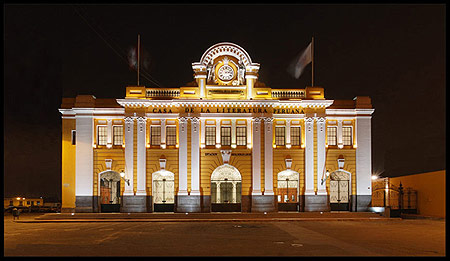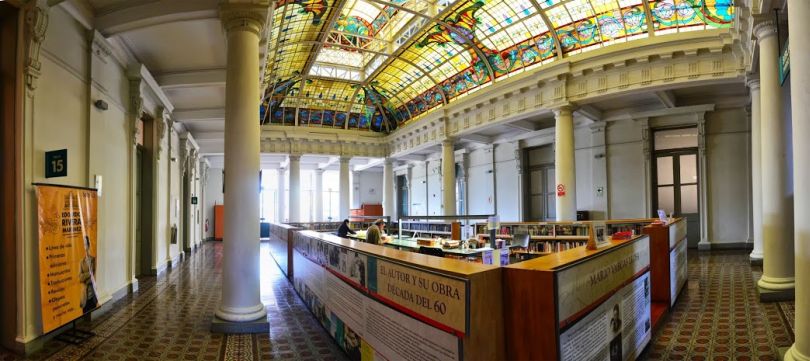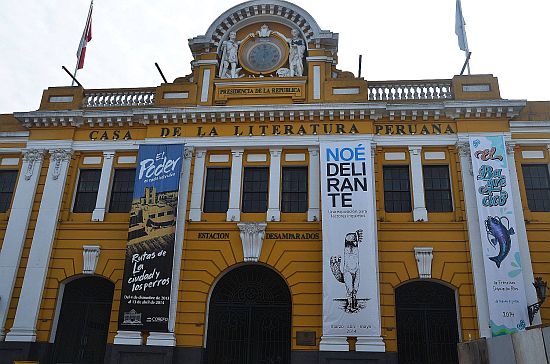
The House of Peruvian Literature, Lima, Peru.
In 2009, the House of Peruvian Literature (Casa de la Literatura Peruana) opened in what was formerly the principal train station of Lima, Peru, built in 1912.
Located in back of the Presidential Palace by the Rímac River, the House of Peruvian Literature retains many decorative elements from the previous station, including glass domes, elegant ironwork, clocks, and even a ticket booth. The building now serves as a library as well as a place for art exhibits and gatherings promoting major modern Peruvian writers. These include the poets César Vallejo and José Santos Chocano, some of whose poems may be read in an anthology in the collection of the Thammasat University Libraries. Another celebrated Peruvian writer is Mario Vargas Llosa, who won the Nobel Prize in Literature in 2010, although he has experienced what some critics have called a mutual love-hate relationship with his native land. For the past 20 years or more, Vargas Llosa has mostly lived in Spain, but visits Peru each year. In 1993 he acquired Spanish citizenship although he is still a Peruvian national. In his Nobel Prize speech Vargas Llosa noted:
I carry Peru deep inside me because that is where I was born, grew up, was formed, and lived those experiences of childhood and youth that shaped my personality and forged my calling, and there I loved, hated, enjoyed, suffered, and dreamed. What happens there affects me more, moves and exasperates me more than what occurs elsewhere.
The TU Libraries own The Temptation of the Impossible: Victor Hugo and Les Miserables by Vargas Llosa. His novels, including Aunt Julia and the Scriptwriter, made into a 1990 Hollywood film, Tune in Tomorrow, starring Keanu Reeves, and The Storyteller may be obtained by interlibrary loan. The same is true of other internationally renowned Peruvian authors not yet represented in our collections, including Jaime Bayly, Ana María Llona Málaga, and Alberto Valdivia Baselli.

High hopes.
When the House of the Peruvian Literature first opened in 2009, the country’s then-president Alan García stated that the new center was intended for all Peruvians, especially young people, who were invited to continue creating. Whether attending poetry readings, borrowing books, or preparing classroom assignments, visitors are welcome. There is also a literary cafe where they can consult the latest periodicals while enjoying a refreshing beverage. In multipurpose rooms, videos are shown and seminars as well as conferences are held.
Thailand and Peru
In 2012, The Nation announced that trade between Thailand and Peru should double after an early-harvest programme under the free-trade agreement went into effect. At the time, His Excellency the Peruvian Ambassador to Thailand Jorge Castaneda stated:
Bilateral trade and investment should grow after the liberalisation of both markets, since current trade and investment are still small because of distance and tariff obstacles. After fully implementing the FTA, both countries should learn to trade more and exchange more investment across the region.
Peruvian investors were considering Thailand as a springboard for the rest of the ASEAN community. For now, Peru’s main import to Thailand is Big Cola, a product known in Peru as Kola Real negra, a subsidiary of the multinational company AJEGROUP. Big Cola has over a 30-percent market share in Thailand. Peru also imports to Thailand natural gas, aquatic products, metal and ore, and garments. In turn, Thailand exports diverse products to Peru, including motor vehicles, parts and accessories, and electrical appliances.
Ambassador Castaneda suggested that Thai investors would find good opportunities in establishing food-processing plants in Peru, where raw materials are abundant. Thai investors might also consider fishery and aquaculture, mining, forestry, textiles and apparel, tourism, telecommunication, real estate, and software in Peru.

One encouraging development, observed by the Ambassador in 2011, is the opening of Peruvian restaurants in Bangkok:
Thai cuisine – which is world famous – and Peruvian food have several elements in common, such as the use of fish, although there are differences such as the use of potatoes in Peruvian food.
The current Peruvian ambassador to the Kingdom, Mr. Felix Ricardo Americo Antonio Denegri Boza, will have noted that as BK Magazine explained in March, genuine Peruvian food can now be tasted at 22 Kitchen & Bar at 946 Silom Road;
Above Eleven in the Fraser Suites Sukhumvit on Sukhumvit Soi 11; and VOF at 66 Rama 9 Soi 41. Peru has varied food products because its territory includes the Andes mountains, the Amazon river, and the Pacific Ocean. Peru grows over 50 kinds of chili and many more kinds of potatoes. Chef Omar Frank Maruy told BK Magazine:
To know about the food, you need to know the history of Peru. We were run by Incas before being conquered by the Spanish. When the Spanish came they influenced a lot of our culture—the language we now speak, the religion and the food. After the Spanish there were waves of migration from Italy, Africa, China and most recently Japan. That makes Peru a fusion country. We’re a little bit of everything.
Among popular dishes are barbecued salmon belly on pressed potato with tomato relish; whole-roasted chicken marinated with cumin and garlic cooked on a skewer over charcoal; and beef and chicken heart marinated with chili, cumin and garlic and dipped in hot sauce.

Beyond cola and food.
As Dr. Kriengsak Chareonwongsak, a senior fellow at the Harvard Kennedy School, Harvard University wrote in a 2010 essay, there is still room for development after decades of diplomatic relations between the Kingdom and the Republic of Peru:
Although relations between Thailand and Peru seem to be in good health, the people of our two countries do not know each other very closely. This is probably due to the remoteness of our geographic locations. For those unsure, Peru is located in the west of South America. Peru’s hospitable and courteous people have created an attractive image for the country’s economy, with beautiful landscapes forming an attractive investment base, together with Peru’s long history to study and learn from. Differences in race, language and culture make the journey to come and get to know Peru a delight, as the case is also for any learning exchange afforded across the Peruvian public domain on a variety of topics, along with their likely associations, no matter how minute. A sense of collaboration with one another in a spirit of brotherhood, and to be happy to help one another in any complementary aspect, where free benefits are available, including an exchange of interests in trade, investment and tourism.
Among specific aspects of future collaborations, Dr. Kriengsak emphasized:
For example, with renewable energy studies, cooperation in world food supply, cooperation in tourism for the historic restoration and conservation of tourist areas, and other cooperative ventures promoting different sectors where there is opportunity to collaborate toward creating a better future together…Our people in both countries can be closely linked together, regardless of our geographic distance or differences in race, language and culture.

(all images courtesy of Wikimedia Commons)
